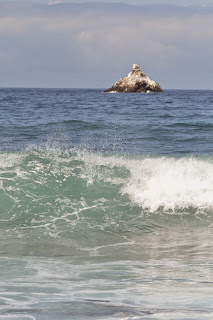
With my two youngest kids I took a day off work to camp and
tidepool over an extended weekend. Long sunny days and cool temperatures – the
weather was perfect.
We camped at Plaskett Creek, a small US Forest Service campsite
just east of California highway 1 in the southern
stretch of Big Sur. Given
that the low tide was very early the next morning, it made for convenient
tidepooling at nearby Sand
Dollar Beach
 |
| Sand Dollar Beach |
 |
| The encrusting sponge, Haliclona. |
On any visit to the coastal rocks my eye is trained for
seaweeds, but my most significant impression of the intertidal biota on this
visit was the abundance of Phragmatopoma
californica, an annelid worm that constructs intricate dwellings of sand at
the edge of intertidal rocks much like a marine beehive. The colonies seemed to
be quite abundant, challenging my memory of whether they were so common on my
visit to this same site years ago.
Returning to the plants, steel grey-green Porphyra were common on rocks in the
high intertidal zone and from the mid-intertidal down there were rich coverings
of seaweeds. Small individuals of giant kelp, Macrocystis pyrifera, were frequent in the lower intertidal and I also
found about three small bull kelp sporophytes.
 |
| Bands of the light brown Phragmatopoma colonies lining intertidal rocks. |
One of the treats of the long drive along the Big Sur coast was spotting 4 grey whales – three near
Willow Creek (a beach access point near the outpost of Gorda) and one farther
north. The group of three swam together close to the rocky shore for quite some
time, surfacing briefly perhaps every minute or so. Their dark grey mottled
backs would appear at the surface, or sometimes a lone flipper would poke into
the air. They frequently swam close together, at some points appearing a pair
appeared to be nestled together.
Grey whales, now mostly only a northeast Pacific species,
migrate annually between Baja California and Alaska . These animals,
the loitering in Big Sur aside (I can’t blame
them), were probably on their way north. Today there are perhaps about 20,000 animals along the west coast of North America ,
so the chance to observe several on our trip was fantastic.
 |
| A trio of grey whales surfacing together. |
 |
| We also saw sundry other marine mammals. |
 |
| Macrocystis pyrifera, giant kelp. |
 |
| Fucus distichus, Silvetia compressa and various red seaweeds on intertidal rocks. |

No comments:
Post a Comment